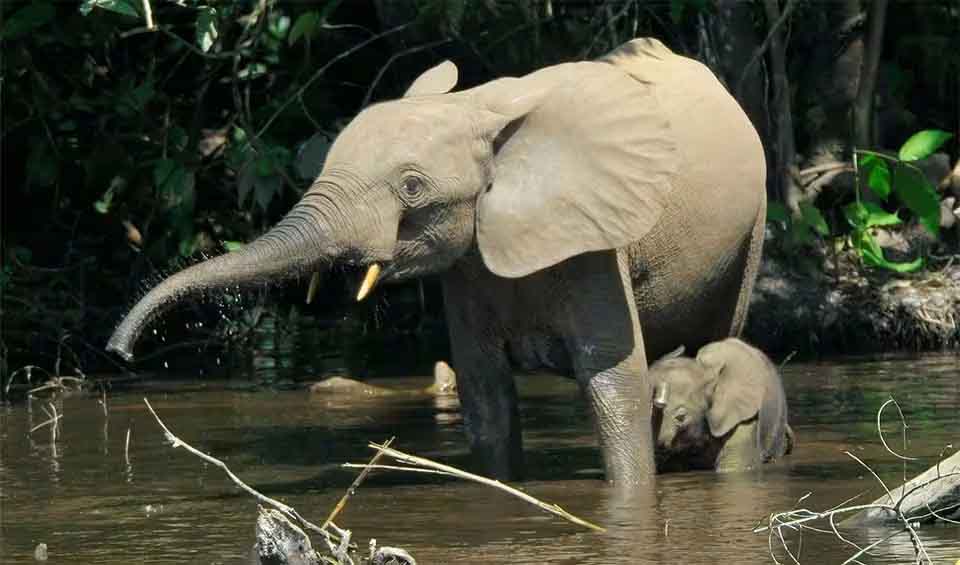The African forest elephant, a distinct cousin of the more widely recognized African bush elephant, plays a crucial role in the biodiversity of the African continent’s dense forests. Smaller in stature, this species exhibits several unique physical characteristics that distinguish it from its savanna-dwelling relatives. Notably, the African forest elephant has more oval-shaped ears, which, alongside its smaller body size, are adaptations to the dense forest environments in which it lives. The tusks of the forest elephant, characterized by their straighter shape and downward point, are not merely physical adornments but are critical tools for foraging in the forest underbrush.
The skin of the African forest elephant is a deep grey, textured with coarse black hair, providing camouflage within the shadowy underbrush of the forest. However, it is their tusks that have become both a blessing and a curse. The ivory of forest elephants is particularly dense, making it highly sought after by poachers for carving and other decorative purposes. This has led to the African forest elephant becoming a prime target for illegal hunting, exacerbating the threats to their survival.
Compounding the peril faced by poaching is the elephant’s notably low reproduction rate, which is the slowest among elephant species. This slow rate of reproduction makes recovery from population declines a daunting challenge. With gestation periods extending up to 22 months and the interval between births being several years, the population growth of forest elephants is painstakingly slow, leaving them vulnerable to the impacts of poaching and habitat destruction.
Distribution
 Angola
Angola Benin
Benin Official estimate
Official estimate
 Burkina Faso
Burkina Faso Cameroon
Cameroon Official estimate
Official estimate
 Central Af. Rep.
Central Af. Rep. Official estimate
Official estimate
 Congo-Brazzaville
Congo-Brazzaville Official estimate
Official estimate
 Côte D’ivoire
Côte D’ivoire Official estimate
Official estimate
 DR Congo (Kinshasa)
DR Congo (Kinshasa) Official estimate
Official estimate
 Equatorial Guinea
Equatorial Guinea Official estimate
Official estimate
 Gabon
Gabon Official estimate
Official estimate
 Gambia
Gambia Official estimate
Official estimate
 Ghana
Ghana Official estimate
Official estimate
 Guinea-Bissau
Guinea-Bissau Official estimate
Official estimate
 Guinea
Guinea Official estimate
Official estimate
 Liberia
Liberia Official estimate
Official estimate
 Niger
Niger Official estimate
Official estimate
 Nigeria
Nigeria Official estimate
Official estimate
 Senegal
Senegal Sierra Leone
Sierra Leone Official estimate
Official estimate
 South Sudan
South Sudan Togo
Togo Official estimate
Official estimate
Recent updates
March 2023: In Gabon, a new AI-powered camera is being tested to help conserve elephant populations by sending real-time data to forest rangers and local villagers, while also detecting other animals, humans, and potential conflicts or illegal activities.
Feb 2023: According to a study, African forest elephants act as gardeners of the African rainforest, helping to store carbon and maintain biodiversity. They also facilitate the growth of plants and trees, contributing to taking carbon out of the atmosphere.
Jan 2023: A new study published in the journal Ecology and Evolution found that African forest elephants are more resilient to habitat fragmentation than previously thought, suggesting that conservation efforts focused on protecting forest corridors may be effective in maintaining healthy elephant populations.
Sep 2022: The government of the Republic of Congo announced that it had established a new national park, Nouabalé-Ndoki National Park, which will provide important habitat for forest elephants as well as other wildlife.
Anything we've missed?
Help us improve this page by suggesting edits. Glory never dies!
Suggest an editGet to know me
Terrestrial / Aquatic
Altricial / Precocial
Polygamous / Monogamous
Dimorphic / Monomorphic
Active: Diurnal / Nocturnal
Social behavior: Solitary / Pack / Herd
Diet: Carnivore / Herbivore / Omnivore / Piscivorous / Insectivore
Migratory: Yes / No
Domesticated: Yes / No
Dangerous: Yes / No





